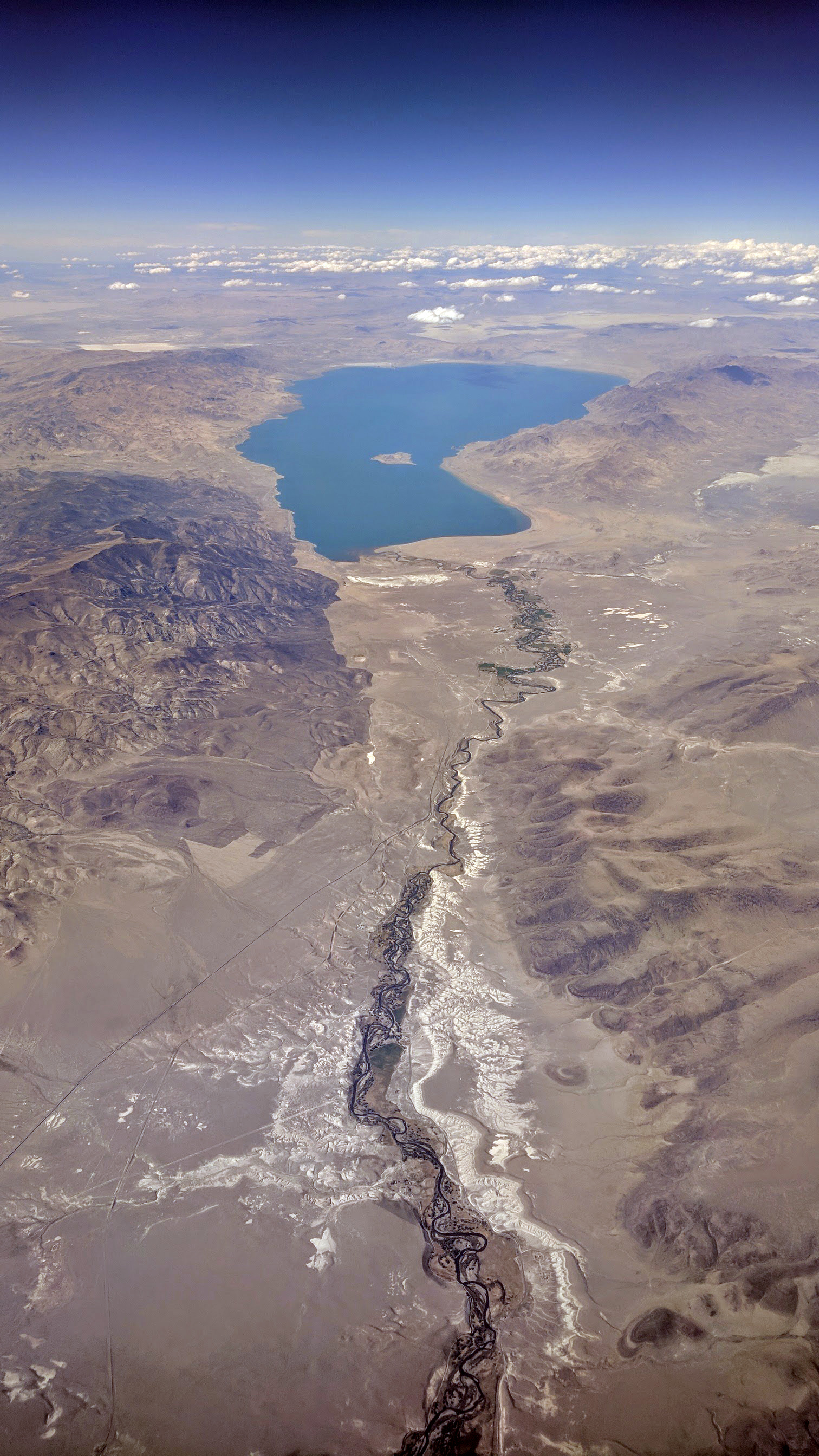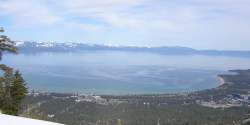|
Lake Lahontan
Lake Lahontan was a large endorheic Pleistocene lake of modern northwestern Nevada that extended into northeastern California and southern Oregon. The area of the former lake is a large portion of the Great Basin that borders the Sacramento River watershed to the west. The lake was named by Clarence King during the Geological Exploration of the Fortieth Parallel. The name honors Louis-Armand de Lom d'Arce de Lahontan, Baron de Lahontan, a French soldier and explorer. History At its peak approximately 12,700 years ago (during a period known as the Sehoo Highstand), the lake had a surface area of over , with its largest component centered at the location of the present Carson Sink. The depth of the lake was about at present day Pyramid Lake, and at the Black Rock Desert. Lake Lahontan, during this most recent glacial period, would have been one of the largest lakes in North America. Climate change around the end of the Pleistocene epoch led to a gradual desiccation of anc ... [...More Info...] [...Related Items...] OR: [Wikipedia] [Google] [Baidu] |
North America
North America is a continent in the Northern Hemisphere and almost entirely within the Western Hemisphere. It is bordered to the north by the Arctic Ocean, to the east by the Atlantic Ocean, to the southeast by South America and the Caribbean Sea, and to the west and south by the Pacific Ocean. Because it is on the North American Plate, North American Tectonic Plate, Greenland is included as a part of North America geographically. North America covers an area of about , about 16.5% of Earth's land area and about 4.8% of its total surface. North America is the third-largest continent by area, following Asia and Africa, and the list of continents and continental subregions by population, fourth by population after Asia, Africa, and Europe. In 2013, its population was estimated at nearly 579 million people in List of sovereign states and dependent territories in North America, 23 independent states, or about 7.5% of the world's population. In Americas (terminology)#Human ge ... [...More Info...] [...Related Items...] OR: [Wikipedia] [Google] [Baidu] |
Lahontan Cutthroat Trout
Lahontan cutthroat trout (''Oncorhynchus clarkii henshawi'') is the largest subspecies of cutthroat trout, and the state fish of Nevada. It is one of three subspecies of cutthroat trout that are listed as federally threatened. Natural history The Lahontan cutthroat is native to the drainages of the Truckee River, Humboldt River, Carson River, Walker River, Quinn River and several smaller rivers in the Great Basin of North America. These were tributaries of ancient and massive Lake Lahontan during the ice ages until the lake shrank to remnants such as Pyramid Lake and Walker Lake about 7,000 years ago, although Lake Tahoe—from which the Truckee flows to Pyramid Lake—is still a large mountain lake. In this sense, Lahontan cutthroats essentially evolved in inland ocean-like conditions. Here, Lahontan cutthroats became a large (up to 1 m or 39 in) and moderately long-lived predator of chub suckers, and other fish as long as 30 or . The trout was able to remain a p ... [...More Info...] [...Related Items...] OR: [Wikipedia] [Google] [Baidu] |
Truckee River
The Truckee River is a river in the U.S. states of California and Nevada. The river flows northeasterly and is long.U.S. Geological Survey. National Hydrography Dataset high-resolution flowline dataThe National Map accessed October 20, 2012 The Truckee is the sole outlet of Lake Tahoe and drains part of the high Sierra Nevada, emptying into Pyramid Lake in the Great Basin. Its waters are an important source of irrigation along its valley and adjacent valleys. Naming of the river When John C. Frémont and Kit Carson ascended the Truckee River on January 16, 1844, they called it the Salmon Trout River, after the huge Lahontan cutthroat trout (''Oncorhynchus clarki henshawi'') that ran up the river from Pyramid Lake to spawn. However, the river was ultimately named after a Paiute chief known as Truckee, who in 1844 guided an emigrant party from the headwaters of the Humboldt River to California via the Truckee River, Donner Lake, and Donner Pass. Appreciative of their Native Amer ... [...More Info...] [...Related Items...] OR: [Wikipedia] [Google] [Baidu] |
DSSAM Model
The DSSAM Model (Dynamic Stream Simulation and Assessment Model) is a computer simulation developed for the Truckee River to analyze water pollution, water quality impacts from land use and wastewater management decisions in the Truckee River Basin. This area includes the cities of Reno, Nevada, Reno and Sparks, Nevada as well as the Lake Tahoe Basin. The model is historically and alternatively called the ''Earth Metrics Truckee River Model''. Since original development in 1984-1986 under contract to the United States Environmental Protection Agency, U.S. Environmental Protection Agency (EPA), the model has been refined and successive versions have been dubbed DSSAM II and DSSAM III. This hydrology transport model is based upon a pollutant loading metric called ''Total maximum daily load (TMDL).'' The success of this flagship model contributed to the Agency's broadened commitment to the use of the underlying TMDL protocol in its national policy for management of most river system ... [...More Info...] [...Related Items...] OR: [Wikipedia] [Google] [Baidu] |
Evaporation
Evaporation is a type of vaporization that occurs on the surface of a liquid as it changes into the gas phase. High concentration of the evaporating substance in the surrounding gas significantly slows down evaporation, such as when humidity affects rate of evaporation of water. When the molecules of the liquid collide, they transfer energy to each other based on how they collide. When a molecule near the surface absorbs enough energy to overcome the vapor pressure, it will escape and enter the surrounding air as a gas. When evaporation occurs, the energy removed from the vaporized liquid will reduce the temperature of the liquid, resulting in evaporative cooling. On average, only a fraction of the molecules in a liquid have enough heat energy to escape from the liquid. The evaporation will continue until an equilibrium is reached when the evaporation of the liquid is equal to its condensation. In an enclosed environment, a liquid will evaporate until the surrounding air is ... [...More Info...] [...Related Items...] OR: [Wikipedia] [Google] [Baidu] |
Tufa
Tufa is a variety of limestone formed when carbonate minerals precipitate out of water in unheated rivers or lakes. Geothermally heated hot springs sometimes produce similar (but less porous) carbonate deposits, which are known as travertine. Tufa is sometimes referred to as (meteogene) travertine. It should not be confused with hot spring (thermogene) travertine. Tufa, which is calcareous, should also not be confused with tuff, a porous volcanic rock with a similar etymology that is sometimes also called "tufa". Classification and features Modern and fossil tufa deposits abound with wetland plants; as such, many tufa deposits are characterised by their large macrobiological component, and are highly porous. Tufa forms either in fluvial channels or in lacustrine environments. Ford and Pedley (1996) provide a review of tufa systems worldwide. Fluvial deposits Deposits can be classified by their depositional environment (or otherwise by vegetation or petrographically). Pedle ... [...More Info...] [...Related Items...] OR: [Wikipedia] [Google] [Baidu] |
Honey Lake
Honey Lake is an endorheic basin, endorheic sink (geography), sink in the Honey Lake Valley in northeastern California, near the Nevada border. Summer evaporation reduces the lake to a lower level of and creates an alkali flat. Honey Lake dries almost completely in most years. Honey Lake recreational activities include bird watching, picnicking, hiking, camping, warm-water fishing, and waterfowl hunting. The lake is part of the Honey–Eagle Lake (Lassen County), Eagle Lakes watershed of which includes the Honey Lake Basin of . History The lake received its name from the Honeydew (secretion), honeydew produced by the abundant aphids inhabiting the area. During the Pleistocene, Honey Lake and the entire Honey Lake Valley were part of Lake Lahontan in western Nevada, with a lake water level of a level of approximately higher than the 1984 level of Honey Lake.''Susanville, California,'' 30x60 Minute Topographic Quadrangle, USGS, 1984 The connection to Lake Lahontan was throug ... [...More Info...] [...Related Items...] OR: [Wikipedia] [Google] [Baidu] |
Winnemucca Lake
Winnemucca Lake is a dry lake bed in northwest Nevada that features the oldest known petroglyphs in North America. Located astride the border between Washoe and Pershing counties, it was a shallow lake until the 1930s, but was dried when a dam and a road were built that combined to restrict and block water flow. It was formerly designated as a National Wildlife Refuge, but its status as a refuge was removed due to the lack of water. Winnemucca Lake is home to several petroglyphs long believed to be very old. In 2013, researchers dated the carvings to between 14,800 and 10,500 years ago. Either date would make them the oldest known petroglyphs found in North America. The carvings lie within the Pyramid Lake Indian Reservation. Geography Winnemucca Lake is a sub-basin within the Lahontan Basin in northwestern Nevada. It lies east of Pyramid Lake and is on the dividing line between Washoe and Pershing counties. The lake bed lies between the Lake Range on the west and the ... [...More Info...] [...Related Items...] OR: [Wikipedia] [Google] [Baidu] |
Walker Lake (Nevada)
Walker Lake is a natural lake in the Great Basin in western Nevada in the United States. It is 11 mi (17 km) long and 5 mi (8 km) wide, in northwestern Mineral County, Nevada, Mineral County along the east side of the Wassuk Range, about 75 mi (120 km) southeast of Reno, Nevada, Reno. The lake is fed from the north by the Walker River and has no natural outlet except absorption and evaporation. The community of Walker Lake, Nevada, Walker Lake is found along the southwest shore. Throughout the 20th century, Walker Lake supported over 50% of the economy of Mineral County through tourism and recreation. From fishing derbies to boat races, water skiing to an annual Loon Festival, the lake was a key part of Mineral County and Walker River Paiute communities. The area around the lake has long been inhabited by the Northern Paiute, Paiute who depended on the lake's fish and bird populations for food. More than a century of upstream irrigation diversions ... [...More Info...] [...Related Items...] OR: [Wikipedia] [Google] [Baidu] |
Humboldt Sink
The Humboldt Sink is an intermittent dry lake bed, approximately 11 mi (18 km) long, and 4 mi (6 km) across, in northwestern Nevada in the United States. The body of water in the sink is known as Humboldt Lake. The sink and its surrounding area was a notorious and dreaded portion (called the Forty Mile Desert) of overland travel to California during the westward migrations of the mid-1800s, which were largely undertaken along the California Trail. Humboldt Sink is located between the West Humboldt Range (to the southeast) and the Trinity Range (to the northwest), on the border between Pershing and Churchill counties, approximately 50 mi (80 km) northeast of Reno. It is fed from the northeast by the 330 miles (530 km) long Humboldt River, the second longest river in the Great Basin of North America (after the Bear River). Interstate 80 passes along the northwest side of the sink. The sink has no natural outlet. A channel connecting it with th ... [...More Info...] [...Related Items...] OR: [Wikipedia] [Google] [Baidu] |
.jpg)





